Take a look back to commemorate our past and to understand how we came to be at the forefront of the struggle for total equality under the law for deaf and hard of hearing Americans. By celebrating our achievements and recognizing our obstacles, we may confidently invest in our future.
Explore by Decade:
Pre-1900 1900 1910 1920 1930 1940 1950 1960 1970 1980 1990 2000
- New England Gallaudet Association of the Deaf founded; serving as a predecessor for the National Association of the Deaf
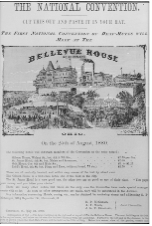
- August 25, 1880. First national convention of Deaf-Mutes held in Cincinnati, Ohio.
- Chaired by Edmund Booth, who announced the purpose of which was to deliberate on the needs of the deaf as a class.
- Robert P. McGregor was elected President of the NAD.
• 1883
- Second national convention held in New York City.
- Edwin Hodgson elected President.
• 1889
- Third national convention held in Washington DC.
- Dudley W. George elected President.
- Statue of Thomas Hopkins Gallaudet and Alice Cogswell unveiled at Gallaudet’s Kendall Green campus.
- “National Association of the Deaf,” adopted as organization’s formal name.
- Resolution passed objecting to discrimination against the deaf in Civil Service and use of “asylums” as reference to schools for the deaf.
• 1893
- Fourth national convention held in Chicago with the Second World Congress of the World Federation of the Deaf.
- Thomas Francis Fox elected President.
- Resolution passed opposing pure oralism as a universal means of instruction of the deaf.
• 1896
- Fifth national convention held in Philadelphia.
- Reverend Jacob M. Koehler elected President; Julia Foley elected as first woman on NAD Board.
- Resolution passed requesting state legislatures not to place state schools for the deaf under the departments of Charities and Corrections.
• 1899
- Sixth national convention held in St. Paul, Minnesota.
- James L. Smith elected President.
- Proposals included combined system for educating deaf children and feasibility of establishing a school for the deaf in Alaska. Need for religious instruction for the deaf also discussed.
- Seventh national convention held in St. Louis, Missouri during the Louisiana Purchase Exposition.
- George Veditz elected President. Education was a major focus.
- The NAD intervened in efforts by certain State Legislatures in California, Washington, and Wisconsin to abandon state schools.
- The NAD advocated for vocational training and schools for the “Colored Deaf.”
- President Smith issued a call for the preservation of sign language.
• 1907
- Eighth national convention held in Norfolk, Virginia.
- Concerns included possible prohibition of intermarriage among deaf individuals. The Committee on Eugenics was chaired by Alexander Graham Bell who proposed to prevent the marriage of those, among others, who were deaf. President Veditz said of Bell, “…because he comes in the guise of a friend, and therefore, the most to be feared enemy of the American deaf, past or present.”
- The NAD formed a committee to address discrimination in federal employment; this led to meetings with Federal Civil Service Commission officials. First move made toward establishment of a $100,000 Endowment Fund.
- Ninth national convention held in Colorado Springs, Colorado.
- Olof Hansen elected President.
- U.S. President William Howard Taft informed the NAD that he instructed the Federal Civil Service Commission to remove all discriminatory barriers to federal employment of deaf workers.
- NAD hosted the World Congress of the World Federation of the Deaf in Colorado Springs.
- Motion Picture Committee formed to preserve sign language from filmed lectures.
• 1913
- Tenth national convention held in Cleveland, Ohio; conventioneers invited as guests at John D. Rockefeller’s home.
- Jay C. Howard elected President.
• 1915
- Eleventh national convention held in San Francisco, California.
- Introduction of a bill in Congress to establish a Bureau for the Deaf in the Department of Labor.
• 1917
- Twelfth national convention held in Hartford, Connecticut, also the centennial of the first permanent school for the deaf in America.
- Reverend James H. Cloud elected President.
- The NAD also offered to recruit 1,000 deaf soldiers for U.S. President Theodore Roosevelt. The NAD promoted “Hire Deaf People— It’s Good Business!” campaign.
- Thirteenth national convention held in Detroit, Michigan.
- Resolution passed stating that anyone who tried to deprive the deaf of the language of signs was an enemy to their interest and happiness.
- The NAD went on record protesting the practice of doctors who attempted to advise parents of deaf children about educational matters. The NAD also fought quack doctors who claimed they could restore hearing, and urged legislation to require doctors to report all cases of deafness to state board of education.
- In at least four states deaf persons were refused driving licenses and other states considered such a ban. There was even some talk of a federal law to require hearing tests for all drivers.
• 1923
- Fourteenth national convention held at Atlanta, Georgia— the first in the Deep South.
- Arthur L. Roberts elected President.
• 1926
- Fifteenth national convention held in Washington DC.
- Concerns expressed about threats to the right to drive automobiles.
- President Roberts urged support for endowment fund with a view toward establishment of a permanent headquarters.
- In 1929, The Philadelphia Record printed statistics which showed that none of the 177 licensed deaf drivers in the city had been involved in an accident. Other areas began reporter similar results.
- Sixteenth national convention held at Buffalo, New York during the fourth World Congress of the Deaf.
- Franklin C. Smielau elected President.
- The NAD presented a memorial statute of Abbé Charles Michael de l’Epée, the founder of the first free school for the deaf in the world to the St. Mary’s Institution for the Deaf in Buffalo, New York.
• 1933
- President Smielau resigned. William H. Schaub became President.
• 1934
- Seventeenth national convention held in New York City, New York. Fiorello LaGuardia, Mayor of New York City, welcomed delegates.
- Marcus L. Kenner elected President.
- NAD affiliates with the National Council of the Physically Handicapped.
- Automobile Legislation Committee provides report on extensive efforts to combat proposed legislation banning deaf individuals from driving automobiles.
• 1937
- Eighteenth national convention held in Chicago, Illinois.
- U.S. President Franklin D. Roosevelt pledged his cooperation to increase civil service opportunities for deaf workers. The NAD reported ongoing work with U.S. Postmaster General to create more employment opportunities for deaf workers.
- The practice of day schools “dumping” their “slow” students on residential schools while proclaiming their oral method to be superior was condemned.
- The NAD also criticized use of the terms “deaf-mute,” “mute,” “deaf-dumb,” “semi-mute,” and “deafened,” and endorsed the terms “deaf” and “hard of hearing.”
- Nineteenth national convention held in Los Angeles, California.
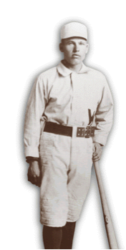
- Tom L. Anderson elected President.
- The NAD supported U.S. Senator Walsh of Massachusetts’ legislative bill to establish a bureau for welfare of the deaf in the U.S. Department of Labor.
• 1946
- Twentieth national convention held in Louisville, Kentucky.
- Byron B. Burnes elected President.
- The NAD abandoned its efforts to establish a federal bureau for welfare of the deaf, pledging instead its cooperation and resources to Vocational Rehabilitation.
- Three club mobiles donated to the American Red Cross by the NAD during World War II.
• 1948
- The NAD sponsored a White House Medal given to Rhulin A. Thomas, the first deaf pilot to fly solo across the U.S.
- The Silent Worker publication is revived by NAD.
- Ford Times printed Arthur H. Lewis’ article, “World’s Safest Drivers” which gave deaf drivers a considerable boost. That article was frequently quoted or referred to years afterwards whenever well-meaning but poorly informed legislators began toying with the idea of introducing legislation to ban deaf drivers.
• 1949
- Twenty-first national convention held in Cleveland, Ohio.
- The NAD undertook a movement to place two deaf professional baseball players, William “Dummy” Hoy and Luther Taylor, in the National Baseball Hall of Fame in Cooperstown, NY.
- Dominating the convention was the need for a permanent NAD headquarters.
- The NAD opens its first office in Chicago, Illinois.
• 1952
- Twenty-second national convention held in Austin, Texas.
- The NAD opposed plans to replace the Kendall School in Washington DC with an oral day school program.
- The NAD office moved from Chicago, Illinois to Berkeley, California.
• 1953
- The NAD opposed a Congressional proposal by U.S. Senator Jacob Javits of New York to grant a tax exemption of $600 to deaf persons, emphasizing an overriding commitment to total equality under the law.
• 1955
- Twenty-third national convention held in Cincinnati, Ohio.
- The NAD received a $17,200 grant from the federal Office of Vocational Rehabilitation to undertake a national survey of occupations among the deaf, and supported a Congressional bill to provide captioned films for the deaf.
- The NAD called for a reorganization meeting in Fulton, Missouri and joined as an Ordinary Member of the World Federation of the Deaf, representing the United States.
• 1956
- The Fulton Tontine (reorganization proposal) held, with the aim of developing recommendations for the restructuring of the NAD.
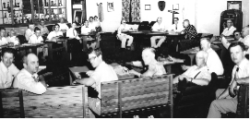
- Results of this first re-organization meeting resulted in rewritten by-laws; establishment of a bicameral system consisting of the NAD Board as one half, and representatives from State Associations as the other half making decisions during conventions
- Proposal increased NAD Board credibility; and developed strategies for financial stability.
• 1957
- Twenty-fourth national convention held in St. Louis, Missouri.
- The NAD received an additional grant of $30,000 to complete its occupational survey.
- The NAD encouraged the World Federation of the Deaf to try for a consultative status to the United Nationals and UNESCO.
- Members approved the Fulton reorganization proposal and sent it to State Associations for ratification.
- Twenty-fifth national convention held in Dallas, Texas.
- First bicameral convention held under the newly ratified Fulton proposal.
- Junior NAD program established with appointment of Mervin Garretson, considered as the “Father of the Junior NAD” as first national director.
- The NAD opposed attempts to eliminate deaf teachers from the education profession.
- Intensive membership drive launched.
- In the 1960s, a Colorado judge named Sherman Finesilver brought national attention to the safe driving records of deaf drivers. He published articles about their driving records, compiled statistics, and conducted defensive driving workshops for them around the country. This publicity was a benefit to deaf people and helped focus increased attention on their safe driving records.
• 1962
- Twenty-sixth national convention held in Miami, Florida.
- Committee formed on Civil Service to continue the battle against discrimination in federal employment.
- Motion passed to explore the possibility of forming a Council of Organizations. President Burnes took part in the World Congress of the World Federation of the Deaf.
• 1964
- Twenty-seventh national convention held in Washington, DC.
- Robert G. Sanderson elected President, ending Byron B. Burnes’ 18-year administration; Burnes was honored with the title President Emeritus.
- Headquarters moved from Berkeley, California to Washington, DC.
- The NAD gives women members the right to vote; deaf blacks will not be granted membership until the following year
• 1966
- Twenty-eighth national convention held in San Francisco, California.
- The NAD voted to hire first full-time executive director and appointed Frederick C. Schreiber.
- The NAD raised funds for and filed an amicus brief in a court case where a deaf couple was denied permission to adopt a foster child. The decision was overturned in favor of the couple.
• 1967
- The NAD received a grant of $75,000 from the Vocational Rehabilitation Administration to conduct an international seminar on research on vocational rehabilitation. Another grant of $48,000 was received to develop a sign language program.
- Terrence O’Rourke was hired to direct the Communication Skills Program.
- The NAD was instrumental in the establishment of the International Association of Parents of the Deaf (IAPD), now named the American Society for Deaf Children (ASDC).
• 1968
- Twenty-ninth convention held in Las Vegas, Nevada.
- Robert O. Lankenau elected President.
- The NAD was instrumental in the establishment of Telecommunications for the Deaf, Inc. (TDI).
- The first Junior NAD Conference was hosted in Washington, DC.
• 1969
- The NAD supported Congressional legislation establishing the National Technical Institute for the Deaf (NTID) at the Rochester Institute of Technology, and the Model Secondary School for the Deaf at Gallaudet College(now named Gallaudet University).
- The NAD established first Youth Leadership Camp (YLC) at Pine Lake Lodge, Stroudsburg, PA
- Thirtieth national convention held in Minneapolis, Minnesota.
- Officer term limits approved and Board membership expanded.
- Historic trans-ocean TTY conversation carried out by officials of the NAD and the Philippine Association of the Deaf.
- A Basic Course in Manual Communication complied by Terrence O’Rourke is published.
• 1971
- The NAD purchased Halex House, a 21,500 square foot building in Silver Spring, Maryland and moves its operations there. The purchase price of the 11-year old home office building was $640,000.
• 1972
- Thirty-first national convention held at Miami Beach, Florida.
- Don G. Pettingill elected President.
- First Miss Deaf America pageant held with Ann Billington crowned as ambassador of goodwill.
- Michael Baer, age 10, established Peewee NAD chapter at the Maryland School for the Deaf.
• 1973
- Halex House officially dedicated on May 19th to the Deaf People of America.
- The NAD successfully advocated for the passage of the Rehabilitation Act of 1973.
• 1974
- Thirty-second national convention held in Seattle, Washington. Jess M. Smith elected President.
- Mary Alice Pearce crowned Miss Deaf America, and later, Pamela Young becomes Miss Deaf America.
- Federally funded project completed and The Deaf Population of the United States published.
• 1975
- The NAD served as USA host for the Seventh World Congress of the World Federation of the Deaf in Washington, DC.
• 1976
- Thirty-third national convention held in Houston, Texas. Mervin D. Garretson elected President.
- President Emeritus Byron B. Burnes appointed to write a history of the NAD for the approaching Centennial Convention.
- Susan Davidoff crowned Miss Deaf America.
- NAD Legal Defense Fund (now named the NAD Law and Advocacy Center) established.
- Sign Instruction Guidance Network (SIGN) within NAD established, later re-named American Sign Language Teachers Association (ASLTA).
- The Federal Communications Commission adopted technological rules for the transmission of closed captioning.
• 1977
- The NAD leads national protest and sit-in at the U.S. Department of Health, Education and Welfare to force issuance of Rehabilitation Act regulations (Section 504 as one of these).
- The NAD establishes National Association of Hearing Impaired Collegiate Students (NAHICS—now known as Collegiate NAD) under leadership of David J. Nelson.
• 1978
- Thirty-fourth national convention held in Rochester, New York.
- Ralph White elected President.
- The NAD undertakes effort to have sign language taught in public schools and accepted as a second language requirement in high school and post-secondary institutions.
- The NAD granted Bernard Bragg $2,000 for a world tour as an advocate for deaf persons’ sign language and the involvement of deaf people in theatre.
- Branch office opened in Indianapolis.
- Jackie Roth crowned Miss Deaf America.
- Federal Communications Commission adopted a rule requiring television licensees to transmit emergency messages in a visual format.
• 1979
- Albert J. Pimental becomes Executive Director. Debra Krausa becomes Miss Deaf America.
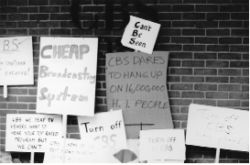
- Thirty-fifth national (centennial) convention held in Cincinnati, Ohio.
- Gertrude S. Galloway elected first female President. Mary Beth Barber crowned Miss Deaf America.
- First television programs captioned.
- NAD published Deaf Heritage by Jack R. Gannon and Sign Language and the Deaf Community: Essays in Honor of William C. Stokoe and established the William C. Stokoe Scholarship Fund (no longer available) to encourage continued research in the area of sign language.
• 1982
- Thirty-sixth national convention held in St. Louis, Missouri.
- T. Alan Hurwitz elected President. Barbara Tubbs crowned Miss Deaf America.
- Real-time captioning debuts.
• 1984
- Thirty-seventh national convention held in Baltimore, Maryland.
- Lawrence H. Forestal elected President. Margo Cienik crowned Miss Deaf America. Gary W. Olsen becomes Executive Director.
- After years of protests, CBS begins closed captioning of the TV show, Dallas.
• 1986
- Thirty-eighth national convention held in Salt Lake City, Utah.
- Lawrence R. Newman elected President. Patricia A. Brennan crowned Miss Deaf America.
- Delegates abolished the President-Elect system, established two member-at-large Board positions, and formed a committee to research feasibility of Interpreter and Sign Language Instructor Evaluation and Certification System.
- The NAD hosts Life and Work in the 21st Century: The Deaf person of Tomorrow and the National Symposium on Sign Language Research and Training in Las Vegas, Nevada.
• 1987
- The NAD issues call for a Deaf President of Gallaudet in October 1987. Headline of The NAD Broadcaster: “A Deaf President? Yes, Deafinitely!”
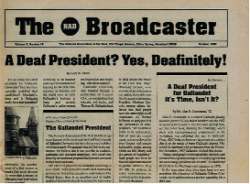
• 1988
- Thirty-ninth national convention held in Charleston, South Carolina.
- Brandeis Sculthorpe crowned Miss Deaf America.
- NAD provided integral support for the Deaf President Now protest at Gallaudet.
- California State University at Northridge (CSUN) wins first College Bowl competition.
- US President Ronald Reagan appoints Executive Director Olsen to serve on Commission on Education of the Deaf.
- The NAD works to increase TTY relay accessibility and the dissemination of TTY equipment. The NAD was also involved in planning the National Forum on Education of the Deaf.
• 1989
- Mervin D. Garretson becomes Executive Director.
- Fulton Revisited Conference held in Phoenix, resulting in expansion of organizational affiliate members.
- Fortieth national convention held in Indianapolis, Indiana.
- Roslyn G. Rosen elected President. Nancylynn Ward crowned Miss Deaf America. Charles C. Estes becomes Executive Director. Gallaudet wins the College Bowl.
- The NAD’s leadership results in passage of Americans with Disabilities Act (ADA) and the Television Decoder Circuitry Act which required all televisions 13 inches or larger to have built-in caption capability.
- The NAD wins a competitive contract through the U.S. Department of Education to administer the federal Captioned Films and Videos (CFV) program, later the Captioned Media Program, which involved evaluation and selection of educational and general interest films/videos for open captioning.
- First position paper on cochlear implants issued.
- Forty-first national convention held in Denver, Colorado.
- Stephanie Long crowned Miss Deaf America.
- Nancy J. Bloch becomes first female Executive Director.
- Gallaudet University wins College Bowl.
- The NAD pushed for adoption of technical standards by the Federal Communications Commission for closed captioning on cable systems.
- Consumer Action Network established by the NAD, now the Deaf and Hard of Hearing Consumer Advocacy Network (DHHCAN).
- Establishment of statewide telecommunications relay services across the nation.
- President William J. Clinton awards Distinguished Service Award to NAD for “distinguished service to America in promoting the dignity, equality, independence and employment of people with disabilities.”
- NAD issues a position paper on “ASL and Bilingual Education”.
- Benjamin J. Soukup appointed President.
- Forty-second national convention held in Knoxville, Tennessee.
- Benjamin J. Soukup elected President. Maureen Yates crowned Miss Deaf America.
- NTID wins College Bowl.
- NAD-RID Task Force on Interpreting formed. First State Association Presidents Conference held.
- NAD established Government Affairs Unit, now part of the NAD Law and Advocacy Center.
- Jennifer Yost becomes Miss Deaf America.
- The NAD wins bid for the second portion of the U.S. Department of Education grant for national distribution of Captioned Films and Videos.
- NAD issues “Television Access” position paper.
- Forty-third national convention held in Portland, Oregon.
- Meghan Lynn Rainone crowned Miss Deaf America. NTID wins College Bowl.
- The NAD successfully advocated for passage of the Telecommunications Act of 1996, which required the FCC to establish captioning rules– which led to 100% captioning for new programs effective January 1, 2006.
- The NAD fought for and won a jury verdict, one of the largest lawsuit awards under the ADA, to a deaf woman who was denied admission to undergraduate education studies.
- President William J. Clinton appoints Executive Director Nancy J. Bloch to the Architectural and Transportation Barriers Compliance Board (Access Board).
• 1997
- The NAD attained key provisions in reauthorization of the Individuals with Disabilities Education Act (IDEA), including recognition of the unique language and communication needs of deaf and hard of hearing children.
• 1998
- Forty-fourth national conference held in San Antonio, Texas. “NAD Convention” changes to “NAD Conference.”
- Elizabeth R. Pollard elected President.
- Amy Wenchuan Wong crowned Miss Deaf America.
- Gallaudet University wins College Bowl.
- The NAD opposed special flagging of deaf test takers on standardized tests, and published Deaf and Sober: Journeys through Recovery by Betty G. Miller.
- The NAD also successfully persuaded the FCC to issue rules leading to increased TV captioning. Congressional censorship of television programs captioned by U.S. Department of Education funds is prevented by the NAD.
• 1999
- The NAD successfully co-drafts and pushes for passage of the Walsh Bill (Newborn and Infant Hearing Screening and Intervention Act of 1999).
- The NAD also provided guidance on regulations for increased access to air travel and airport facilities, persuaded Gore Commission to approve language for expansion of digital TV access, corrected legislative funding inequity for funding of deaf athletes, gave support to Video Relay Services pilot programs and settled lawsuits against several hospitals across the nation for failure to provide interpreters and established model policies for access. The NAD supported the Violence Against Women Act and Hate Crimes Prevention Act, co-sponsored National Symposium on Childhood Deafness, took part in First White House Conference on Mental Health, pushed for passage of Work Incentives Improvement Act and persuaded the FCC to issue Section 255 rules requiring telecommunication services and equipment to be accessible and compatible.
- Forty-fifth national conference held in Norfolk, Virginia.
- Lauren Teruel crowned Miss Deaf America. Gallaudet University wins College Bowl.
- The NAD successfully persuaded the FCC to recognize Video Relay Services and Collaborated on the National Deaf Education Project which published The Educational and Communication Needs of Deaf and Hard of Hearing Children: A statement of Principle Regarding Fundamental Systemic Educational Changes by Lawrence Siegel.
- Settled landmark NAD lawsuit against City of Houston for failure to provide access to the criminal justice system.
- Issued national chart on state interpreting certification and licensure requirements and offered model state legislation as well as guidance on State Universal Newborn Hearing Screening requirements and offered model state legislation.
- Issued a new position statement on “Communication Access by Law Enforcement Personnel” and revised the position paper on “Cochlear Implants.”
- Persuaded the FCC to release rules requiring captioning of emergency information. The NAD also organized a Get out the Vote campaign, and posted a fact sheet on “Getting Mental Health Services.”
• 2001
- The NAD settled lawsuit against a team of doctors who refused to provide interpreters.
- Co-founded “United We Stand” fund with National Fraternal Society of the Deaf (NFSD) for terrorist disaster relief purposes.
- Distributed model ASL bill for state legislatures.
- Co-sponsored National Symposium on Childhood Deafness. Issued Coalition for Movie Captioning position statement on “Access to Moviegoers Who are Deaf, Hard of Hearing or Late-Deafened.”
• 2002
- Forty-sixth national conference held in Washington, DC.
- Kent Kennedy elected President. Tyese Wright crowned Miss Deaf America. NTID wins College Bowl.
- The NAD successfully persuaded the FCC to recognize Internet Protocol Relay Services. Supported federal legislation increasing access and availability of broadband services.
- Supported federal legislation protecting affordable housing for people with disabilities.
- Issued three position statements: “Communication Services for Students Who are Deaf or Hard of Hearing at Colleges and Universities,” “Inclusion,” and “High Stakes Assessment and Accountability.” Pushed for hearing aid compatibility for digital wireless telephones.
• 2003
- Andrew J. Lange appointed President.
- The NAD successfully persuades the FCC to recognize Captioned Telephone services, and co-sponsored the National Symposium on Childhood Deafness.
- Led in the establishment of Deaf and Hard of Hearing Accessibility Working Group with focus on transportation access. Supported Real Time Caption Writers Act.
- Settled a lawsuit insuring that a certified deaf softball umpire has access to interpreters for meetings and supported Hearing Aid Assistance Tax Credit Act.
- Mobilized support saying the state could not compel foster children to undergo elective cochlear implant surgery.
- Petitioned the FCC to require that all technology that uses monitors or screens have captioning capabilities.
- Opposed the ADA Notification Act.
- Newborn and infant hearing screening hits 90%, as an outcome of NAD advocacy efforts.
- Position statement on “Mental Health Services for People Who are Deaf or Hard of Hearing” and white paper on “Individuals with Disabilities Education Act” issued.
• 2005
- The NAD celebrates its 125th Anniversary with a National Gala and a State Association National Conference, in Baltimore, Maryland.
- Successfully persuaded the FCC to adopt VRS standards including 24 hours/7 days a week requirements.
- Pushed for acceptance of petition urging better television captioning quality and enforcement. Convinces FCC to charge fines against television stations for failure to caption emergency information. Captioned movie access increases exponentially through NAD efforts as part of the Coalition for Movie Captioning.
- Settles discrimination suits against mortgage and title companies, and against Ellis Island, both for failing to provide access.
• 2008
- 49th national convention held in New Orleans
- Advocated for 10 digit VRS numbering and access to E-911 services
- Filed a position paper on ASL as an essential human right
• 2009
- Supported U.S. signing of the UN’s Convention on the Rights of Persons with Disabilities (CRPD)
- Supported 21st Century Communications and Video Accessibility Act, which updates Federal regulation to protect disability rights in communication to include the evolving forms of video and internet-based technology.
